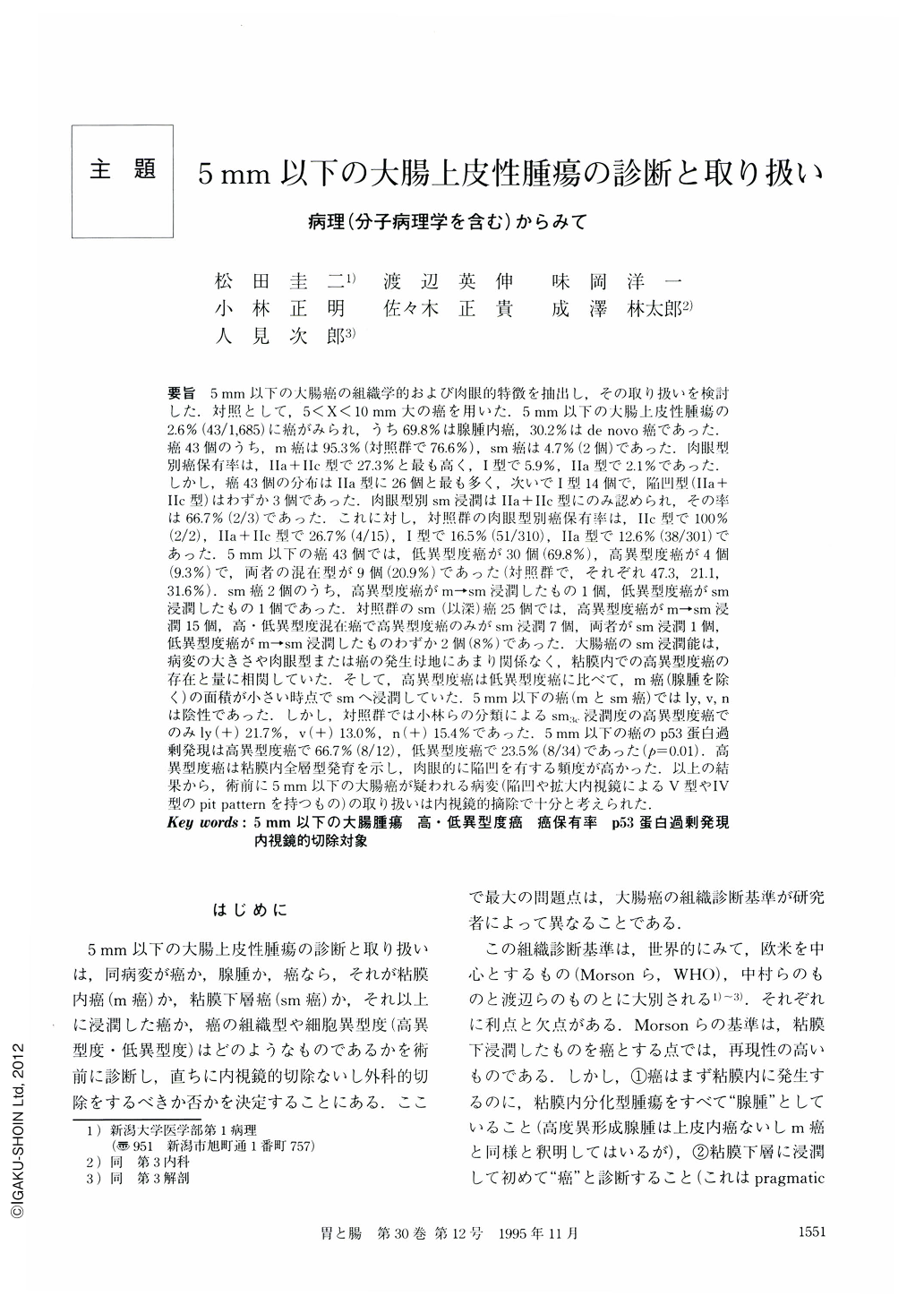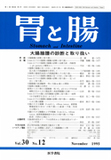Japanese
English
- 有料閲覧
- Abstract 文献概要
- 1ページ目 Look Inside
- サイト内被引用 Cited by
要旨 5mm以下の大腸癌の組織学的および肉眼的特徴を抽出し,その取り扱いを検討した.対照として,5<X<10mm大の癌を用いた.5mm以下の大腸上皮性腫瘍の2.6%(43/1,685)に癌がみられ,うち69.8%は腺腫内癌,30.2%はde novo癌であった.癌43個のうち,m癌は95.3%(対照群で76.6%),sm癌は4.7%(2個)であった.肉眼型別癌保有率は,IIa+IIc型で27.3%と最も高く,I型で5.9%,IIa型で2.1%であった,しかし,癌43個の分布はIIa型に26個と最も多く,次いでI型14個で,陥凹型(IIa+IIc型)はわずか3個であった.肉眼型別sm浸潤はIIa+IIc型にのみ認められ,その率は66.7%(2/3)であった.これに対し,対照群の肉眼型別癌保有率は,IIc型で100%(2/2),IIa+IIc型で26.7%(4/15),I型で16.5%(51/310),IIa型で12.6%(38/301)であった.5mm以下の癌43個では,低異型度癌が30個(69.8%),高異型度癌が4個(9.3%)で,両者の混在型が9個(20.9%)であった(対照群で,それぞれ47.3,21.1,31,6%).sm癌2個のうち,高異型度癌がm→sm浸潤したもの1個,低異型度癌がsm浸潤したもの1個であった.対照群のsm(以深)癌25個では,高異型度癌がm→sm浸潤15個,高・低異型度混在癌で高異型度癌のみがsm浸潤7個,両者がsm浸潤1個,低異型度癌がm→sm浸潤したものわずか2個(8%)であった.大腸癌のsm浸潤能は,病変の大きさや肉眼型または癌の発生母地にあまり関係なく,粘膜内での高異型度癌の存在と量に相関していた.そして,高異型度癌は低異型度癌に比べて,m癌(腺腫を除く)の面積が小さい時点でsmへ浸潤していた.5mm以下の癌(mとsm癌)ではly,v,nは陰性であった.しかし,対照群では小林らの分類によるsm3c,浸潤度の高異型度癌でのみly(+)21.7%,v(+)13.0%,n(+)15.4%であった.5mm以下の癌のp53蛋白過剰発現は高異型度癌で66.7%(8/12),低異型度癌で23.5%(8/34)であった(p=0.01).高異型度癌は粘膜内全層型発育を示し,肉眼的に陥凹を有する頻度が高かった.以上の結果から,術前に5mm以下の大腸癌が疑われる病変(陥凹や拡大内視鏡によるV型やIV型のpit patternを持つもの)の取り扱いは内視鏡的摘除で十分と考えられた.
We studied histological and macroscopical features of colorectal microcarcinomas measuring 5 mm or less, and how to treat such tumors. As controls, small colorectal cancers measuring 5<X<10 mm were used. Microcarcinoma was found in 43 of 1,685 (2.6%) colorectal epithelial tumors measuring 5 mm or less. Out of them, carcinomas in adenoma were 69.8% (30/43) and de novo carcinomas 30.2% (13/43). Forty-one of the 43 cancers (95.3%) were intramucosal carcinoma (control : 76.0%, 82/107), and two (4.7%) were submucosal carcinomas. Frequency of carcinoma by macroscopic type of microepithelial tumors was 27.3% (3/11) in IIa+IIc type, 5.9% (14/238) of I type, and 2.1% (26/1258) of IIa type. But IIa type cancers were most in number, i.e. 26 of 43 cancers (60.5%), and next I type were 14 (32.5%), and IIa+IIc type were only three (7.5%). In microcarcinomas, submucosal invasion was found in IIa+IIc type alone, and the rate was 66.7% (2/3). On the other hand, the frequency of carcinoma by macroscopic type in controls was 100% (2/2) in IIc type, 26.7% (4/15) in IIa+IIc type, 16.5% (51/310) in I type, 12.6% (38/301) in IIa type. Fortythree microcarcinomas was composed of 30 (69.8%) cytologically low-grade carcinomas (CAL), four (9.3%) high-grade (CAH) and nine (20.9%) mixed low-and high-grade cancers (in controls, 47.4%, 21.0% and 31.0%, respectively). In two submucosal microcarcinomas each one of CAH and CAL invaded the submucosa. While, in controls of 25 submucosal cancers 15 CAHs invaded the submucosa (m : CAH→sm : CAH), CAH part invaded the submucosa in seven of eight tumors with mixed CAH and CAL (m : CAH and L→ sm : CAH) and both parts into submucosa in one of the eight (m : CAH and L→ sm : CAH and L), and only two CALs (8%) into the submucosa (m : CAL→ sm : CAL). Submucosal invasive activity of colorectal microcarcinoma and small carcinoma did not correlate with size, macroscopic type or histological background of carcinoma, but correlated with presence and quantity of CAH in the mucosa. CAH invaded the submucosa in a smaller size compared with CAL. Submucosal microcarcinomas were negative for vascular permeation and lymph nodal metastasis, but in control submucosal cancers were positive for lymphatic permeation (21.7%), vascular invasion (13.0%) and node metastasis (15.4%). The rate of p53 protein overexpression was significantly higher in CAH (containing) microcarcinomas (66.7%, 8/12) than in CALs (23.5%, 8/34) (p = 0.01). CAH occupied the entire mucosa at a high frequency (CAH : 77.8% vs CAL : 19.4%) and macroscopically showed more frequent depression (30.0%) than CAL (9.1%). These data suggest that endoscopic resection is enough as a treatment of the lesions suggestive of colorectal microcarcinoma.

Copyright © 1995, Igaku-Shoin Ltd. All rights reserved.


